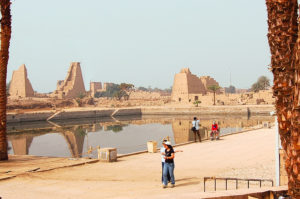
Sacred Lake at Karnak Temple (Photo by Don Knebel)
In about 2000 B.C., Pharaoh Sesostris ordered construction of a temple near what is now Luxor, Egypt. For 1300 years, his successors kept building on the same site until the collection of temples, halls and obelisks occupied 200 acres. Facilities devoted just to Amun, one of the most important of the gods worshipped at Karnak, occupied 61 acres. In about 1450 B.C., Pharaoh Tuthmosis III built an artificial lake lined with stone, 425 feet long by 250 wide, just south of the main Temple of Amun. Stone steps on the perimeter of this Sacred Lake lead into the water, which symbolized the primeval waters of creation. Priests living in special quarters south of the Sacred Lake used the lake to purify themselves before performing religious rituals in the temples of Amun.
According to the Bible, after the Israelites had left Egypt under the leadership of Moses, they fashioned a bronze basin and placed it near the entrance of their portable Tabernacle, where the priests purified themselves in water before performing religious rituals. When King Solomon built the Temple in Jerusalem he placed a large bronze basin called the Molten Sea near the Temple, where priests ritually purified themselves and their vessels. Moses’ basin and Solomon’s Molten Sea are echoed in Jewish mikvahs, Christian baptismal founts and Muslim ablution pools.
Some people have speculated (probably incorrectly) that the word “amen,” used in many of the world’s religions, is connected with the god Amun, who was worshipped at Karnak. Far more likely is the conclusion that the widespread practice of using water for ritual purification may have begun at Karnak’s Sacred Lake almost 3500 years ago.
Comments are closed.